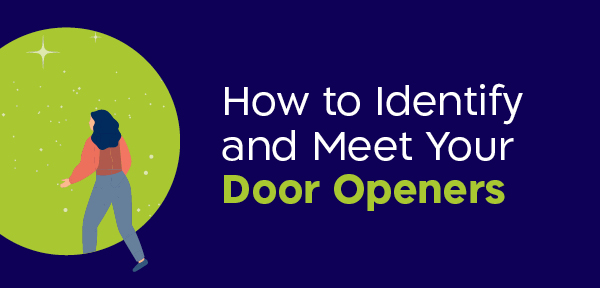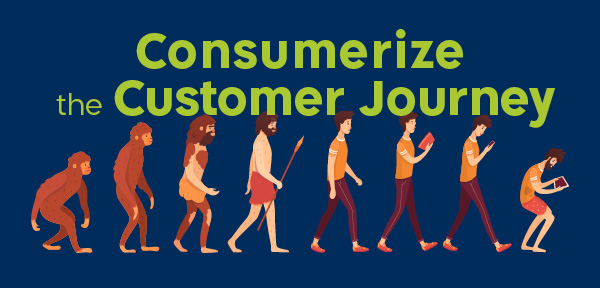Nirit Elyovich Recent Posts
How to Identify and Meet Your Door Openers
By
Nirit Elyovich
, 26/03/2023
How to Identify and Meet Your Door Openers How can you identify and get to know the people who are in the right position to open the door for you? In a recent webinar, Nirit Elyovich, our VP Strategy, shared some key insights.
min read
How to Identify and Meet Your Door Openers
How can you identify and get to know the people who are in the right position to open the door for you? In a recent webinar, Nirit Elyovich, our VP Strategy, shared some key insights.
Whether you are refining your existing value proposition to maximize its potential, launching a new product line that appeals to a different audience, expanding into a new vertical or penetrating a new market, there’s one common denominator that plays a vital role in your marketing strategy — meeting and influencing your door openers.
Whose Doors Should You Be Knocking On?
It’s the million dollar question. How do you successfully identify the key personas who will open the right doors for your company?
It’s not always clearcut. There are many decision makers inside and outside organizations. It’s especially true in the B2B world, where there are a rich variety of decision makers in the purchasing journey.
Knowing who to speak to is the key to opening the right door. That means understanding —
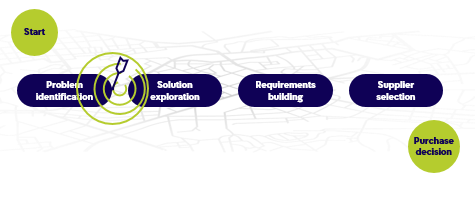 1. Stay as close to the beginning of the purchase journey as possible
The role of marketing is to generate demand. The earlier we meet the interested parties at the beginning of the purchase journey, the more we will increase our chances of entering the consideration set — to be one of the suppliers they are considering.
This is the point when they realize that there is a problem. As the need arises, they begin to learn about the alternatives that exist in the market. It's time for you to enter the picture.
Key takeaway: Find the earliest point in the purchase journey, even before your potential customers start contacting suppliers.
2. Expand your search beyond the obvious and cast a wider net – to influencers and KOLs
Entire industries are undergoing a shake-up and need to update their business strategy. In this scenario, it’s strategic consulting companies that will be recommending new business directions to them. If a high-profile consulting company recommends you, you’ve done your part. Obviously, they won't recommend you if they don't know about you. But if you recognize them as the ones who can open the door for you and you bring your company to their attention, new horizons will open up for you.
If you’re working in the same space with complementary companies, leverage it. As an example, companies in the agritech space are all targeting the same growers. They don’t compete but complement one another. Growers are already working with a company trusts them. If they recommend you, then your chances of setting a meeting and staying to build a relationship, are far greater.
Key takeaway: Differentiate yourself and try to reach your door openers through avenues that others haven’t yet discovered.
3. Copy your ideal customer
Think of a customer of yours that you would like to duplicate. Your potential dream client — the one who, if you get it right, will allow you to duplicate your offer to lookalike clients.
It’s really what a persona is all about — a typical figure that represents your target audience. The idea is to learn from the individual and expand it to a broader audience. If it’s too niche and cannot be replicated, it won't really help you.
Key takeaway: If it works, do it again!
How can you get to know your door openers better?
Each persona has their own "buttons", that when pushed cause them to act. If you know what motivates your door openers, you’ll be able to reach them. That's why it's important to build a profile for each persona you’ve chosen.
1. Stay as close to the beginning of the purchase journey as possible
The role of marketing is to generate demand. The earlier we meet the interested parties at the beginning of the purchase journey, the more we will increase our chances of entering the consideration set — to be one of the suppliers they are considering.
This is the point when they realize that there is a problem. As the need arises, they begin to learn about the alternatives that exist in the market. It's time for you to enter the picture.
Key takeaway: Find the earliest point in the purchase journey, even before your potential customers start contacting suppliers.
2. Expand your search beyond the obvious and cast a wider net – to influencers and KOLs
Entire industries are undergoing a shake-up and need to update their business strategy. In this scenario, it’s strategic consulting companies that will be recommending new business directions to them. If a high-profile consulting company recommends you, you’ve done your part. Obviously, they won't recommend you if they don't know about you. But if you recognize them as the ones who can open the door for you and you bring your company to their attention, new horizons will open up for you.
If you’re working in the same space with complementary companies, leverage it. As an example, companies in the agritech space are all targeting the same growers. They don’t compete but complement one another. Growers are already working with a company trusts them. If they recommend you, then your chances of setting a meeting and staying to build a relationship, are far greater.
Key takeaway: Differentiate yourself and try to reach your door openers through avenues that others haven’t yet discovered.
3. Copy your ideal customer
Think of a customer of yours that you would like to duplicate. Your potential dream client — the one who, if you get it right, will allow you to duplicate your offer to lookalike clients.
It’s really what a persona is all about — a typical figure that represents your target audience. The idea is to learn from the individual and expand it to a broader audience. If it’s too niche and cannot be replicated, it won't really help you.
Key takeaway: If it works, do it again!
How can you get to know your door openers better?
Each persona has their own "buttons", that when pushed cause them to act. If you know what motivates your door openers, you’ll be able to reach them. That's why it's important to build a profile for each persona you’ve chosen.
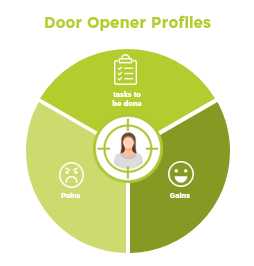 Every persona, even in the same organization, is motivated by different things. There’s no single message that motivates everyone. To get a clearer picture, ask yourself these questions:
Every persona, even in the same organization, is motivated by different things. There’s no single message that motivates everyone. To get a clearer picture, ask yourself these questions:
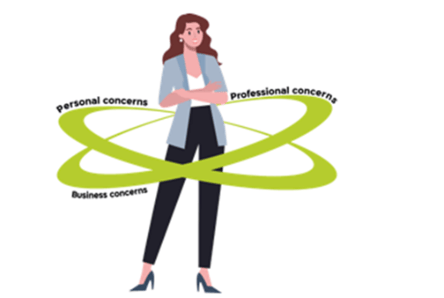 To convince someone to let you in the door, they must be convinced that it will bring significant value both to the company and themselves.
Meir Ariel sings, "The doors guess who I am and open by themselves." It would be great if that was true in the business world, where the doors we are looking don’t recognize us and won’t open by themselves.
Knock, knock, knocking on the right door
To sum up, when you focus on the beginning of the customer journey, expand your view to less obvious places, and know which persona profile you’re looking for, there’s a good chance you will reach the people who can open the door for you. Then all you have to do is enter.
To convince someone to let you in the door, they must be convinced that it will bring significant value both to the company and themselves.
Meir Ariel sings, "The doors guess who I am and open by themselves." It would be great if that was true in the business world, where the doors we are looking don’t recognize us and won’t open by themselves.
Knock, knock, knocking on the right door
To sum up, when you focus on the beginning of the customer journey, expand your view to less obvious places, and know which persona profile you’re looking for, there’s a good chance you will reach the people who can open the door for you. Then all you have to do is enter.
- Who are the door openers?
- How can you get to know them better?
 1. Stay as close to the beginning of the purchase journey as possible
The role of marketing is to generate demand. The earlier we meet the interested parties at the beginning of the purchase journey, the more we will increase our chances of entering the consideration set — to be one of the suppliers they are considering.
This is the point when they realize that there is a problem. As the need arises, they begin to learn about the alternatives that exist in the market. It's time for you to enter the picture.
Key takeaway: Find the earliest point in the purchase journey, even before your potential customers start contacting suppliers.
2. Expand your search beyond the obvious and cast a wider net – to influencers and KOLs
Entire industries are undergoing a shake-up and need to update their business strategy. In this scenario, it’s strategic consulting companies that will be recommending new business directions to them. If a high-profile consulting company recommends you, you’ve done your part. Obviously, they won't recommend you if they don't know about you. But if you recognize them as the ones who can open the door for you and you bring your company to their attention, new horizons will open up for you.
If you’re working in the same space with complementary companies, leverage it. As an example, companies in the agritech space are all targeting the same growers. They don’t compete but complement one another. Growers are already working with a company trusts them. If they recommend you, then your chances of setting a meeting and staying to build a relationship, are far greater.
Key takeaway: Differentiate yourself and try to reach your door openers through avenues that others haven’t yet discovered.
3. Copy your ideal customer
Think of a customer of yours that you would like to duplicate. Your potential dream client — the one who, if you get it right, will allow you to duplicate your offer to lookalike clients.
It’s really what a persona is all about — a typical figure that represents your target audience. The idea is to learn from the individual and expand it to a broader audience. If it’s too niche and cannot be replicated, it won't really help you.
Key takeaway: If it works, do it again!
How can you get to know your door openers better?
Each persona has their own "buttons", that when pushed cause them to act. If you know what motivates your door openers, you’ll be able to reach them. That's why it's important to build a profile for each persona you’ve chosen.
1. Stay as close to the beginning of the purchase journey as possible
The role of marketing is to generate demand. The earlier we meet the interested parties at the beginning of the purchase journey, the more we will increase our chances of entering the consideration set — to be one of the suppliers they are considering.
This is the point when they realize that there is a problem. As the need arises, they begin to learn about the alternatives that exist in the market. It's time for you to enter the picture.
Key takeaway: Find the earliest point in the purchase journey, even before your potential customers start contacting suppliers.
2. Expand your search beyond the obvious and cast a wider net – to influencers and KOLs
Entire industries are undergoing a shake-up and need to update their business strategy. In this scenario, it’s strategic consulting companies that will be recommending new business directions to them. If a high-profile consulting company recommends you, you’ve done your part. Obviously, they won't recommend you if they don't know about you. But if you recognize them as the ones who can open the door for you and you bring your company to their attention, new horizons will open up for you.
If you’re working in the same space with complementary companies, leverage it. As an example, companies in the agritech space are all targeting the same growers. They don’t compete but complement one another. Growers are already working with a company trusts them. If they recommend you, then your chances of setting a meeting and staying to build a relationship, are far greater.
Key takeaway: Differentiate yourself and try to reach your door openers through avenues that others haven’t yet discovered.
3. Copy your ideal customer
Think of a customer of yours that you would like to duplicate. Your potential dream client — the one who, if you get it right, will allow you to duplicate your offer to lookalike clients.
It’s really what a persona is all about — a typical figure that represents your target audience. The idea is to learn from the individual and expand it to a broader audience. If it’s too niche and cannot be replicated, it won't really help you.
Key takeaway: If it works, do it again!
How can you get to know your door openers better?
Each persona has their own "buttons", that when pushed cause them to act. If you know what motivates your door openers, you’ll be able to reach them. That's why it's important to build a profile for each persona you’ve chosen.
 Every persona, even in the same organization, is motivated by different things. There’s no single message that motivates everyone. To get a clearer picture, ask yourself these questions:
Every persona, even in the same organization, is motivated by different things. There’s no single message that motivates everyone. To get a clearer picture, ask yourself these questions:
- What tasks need to be done — What is on the decision maker’s plate? Typically, people only listen if it’s in their scope of activity. This is critical!
- What are the aspirations of each persona — What do they want to achieve within their role? In short, what are their “gains?”
- What are their pain points — What makes it difficult to achieve their goals?
 To convince someone to let you in the door, they must be convinced that it will bring significant value both to the company and themselves.
Meir Ariel sings, "The doors guess who I am and open by themselves." It would be great if that was true in the business world, where the doors we are looking don’t recognize us and won’t open by themselves.
Knock, knock, knocking on the right door
To sum up, when you focus on the beginning of the customer journey, expand your view to less obvious places, and know which persona profile you’re looking for, there’s a good chance you will reach the people who can open the door for you. Then all you have to do is enter.
To convince someone to let you in the door, they must be convinced that it will bring significant value both to the company and themselves.
Meir Ariel sings, "The doors guess who I am and open by themselves." It would be great if that was true in the business world, where the doors we are looking don’t recognize us and won’t open by themselves.
Knock, knock, knocking on the right door
To sum up, when you focus on the beginning of the customer journey, expand your view to less obvious places, and know which persona profile you’re looking for, there’s a good chance you will reach the people who can open the door for you. Then all you have to do is enter.
Consumerize the Customer Journey
By
Nirit Elyovich
, 25/01/2022
Early in my career, a wise woman said customers pay my salary, not owners. It's vital for marketers to consider future customers' needs.
min read
When I just started my career, an intelligent woman told me that only when I understand that the customers of the company pay my salary and not the company owners, will I be able to call myself a marketer. So when you think about the future of marketing, you need to first consider what kind of customers we will meet.
Let’s talk about how you “consumerize” the customer journey; how you look at the B2B (Business to Business) customer a bit like a consumer.
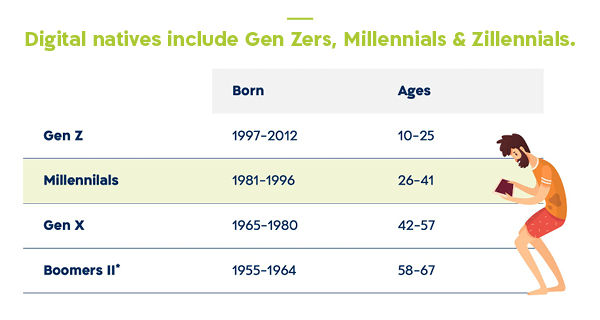 The millennials, also known as Generation Y, were born after 1980. They are now in their 30’s. Generation Z, as you can see in the table, is still young, but we will soon see them influencing our businesses. Since technology is changing very quickly, a sub-generation was born between the Millennials and Generation Z. Zillennials were born between ‘93-‘98 and were influenced by more advanced technology than the Millennials.
For their entire lives, digital natives have been surrounded by technology, social media, mobile devices, computers, and the internet. They speak this digital language as their mother tongue. They did not learn this language in their 20’s, 30’s, or later. They do not have an accent, so to speak.
The millennials, also known as Generation Y, were born after 1980. They are now in their 30’s. Generation Z, as you can see in the table, is still young, but we will soon see them influencing our businesses. Since technology is changing very quickly, a sub-generation was born between the Millennials and Generation Z. Zillennials were born between ‘93-‘98 and were influenced by more advanced technology than the Millennials.
For their entire lives, digital natives have been surrounded by technology, social media, mobile devices, computers, and the internet. They speak this digital language as their mother tongue. They did not learn this language in their 20’s, 30’s, or later. They do not have an accent, so to speak.
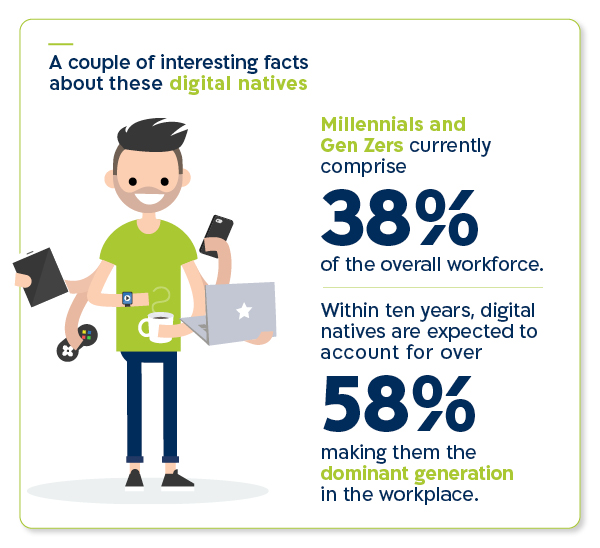
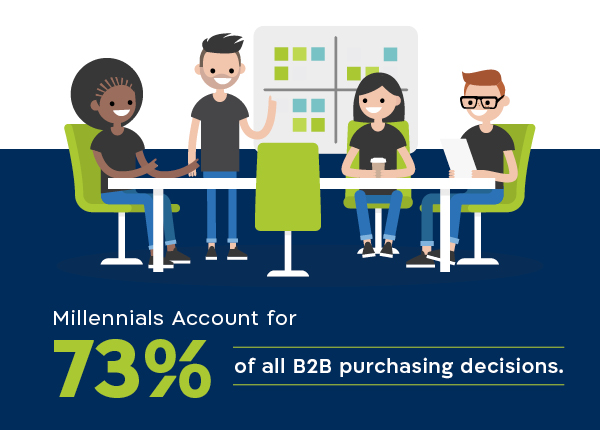 This impressive figure tells the whole story: More and more millennials and gen zers are entering the B2B decision journey, some as technological or professional influencers and others as decision-makers. It is important to note that among the people involved in decision-making, you usually meet several generations.
A few months ago, we at Oz Global B2B did a project for the American agricultural market. The intergenerational integration in the decision-making process that arose there was very prominent.
This impressive figure tells the whole story: More and more millennials and gen zers are entering the B2B decision journey, some as technological or professional influencers and others as decision-makers. It is important to note that among the people involved in decision-making, you usually meet several generations.
A few months ago, we at Oz Global B2B did a project for the American agricultural market. The intergenerational integration in the decision-making process that arose there was very prominent.
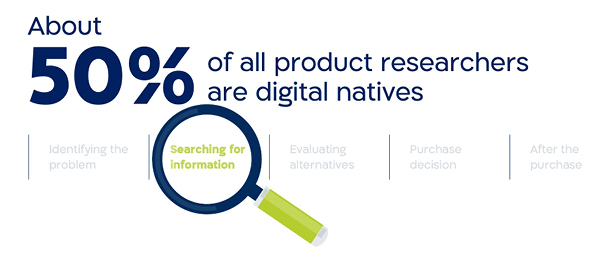 By the time the customer recognizes that he has a problem, we are, in most cases, not there. Identification is an internal stage from which someone is appointed to start researching information to find options for a solution.
50% of those who conduct the research and seek alternatives regarding a product or service, may not take an "official" part in decision-making but are the ones who put the relevant suppliers in the decision-making funnel. They are the ones who build the long list. They are the ones who decide whether or not you will be included in the “consideration group,” which is of critical importance.
By the time the customer recognizes that he has a problem, we are, in most cases, not there. Identification is an internal stage from which someone is appointed to start researching information to find options for a solution.
50% of those who conduct the research and seek alternatives regarding a product or service, may not take an "official" part in decision-making but are the ones who put the relevant suppliers in the decision-making funnel. They are the ones who build the long list. They are the ones who decide whether or not you will be included in the “consideration group,” which is of critical importance.
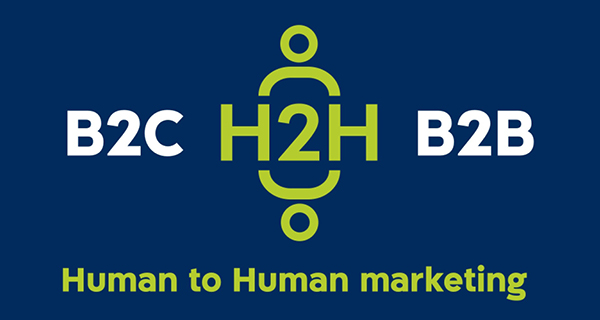
The new B2B customer is a digital native
Our childhood determines our future behaviors as adults, the people we become, and the decision-makers we grow up to be. It is also true of the technological environment in which we were raised. The millennials, also known as Generation Y, were born after 1980. They are now in their 30’s. Generation Z, as you can see in the table, is still young, but we will soon see them influencing our businesses. Since technology is changing very quickly, a sub-generation was born between the Millennials and Generation Z. Zillennials were born between ‘93-‘98 and were influenced by more advanced technology than the Millennials.
For their entire lives, digital natives have been surrounded by technology, social media, mobile devices, computers, and the internet. They speak this digital language as their mother tongue. They did not learn this language in their 20’s, 30’s, or later. They do not have an accent, so to speak.
The millennials, also known as Generation Y, were born after 1980. They are now in their 30’s. Generation Z, as you can see in the table, is still young, but we will soon see them influencing our businesses. Since technology is changing very quickly, a sub-generation was born between the Millennials and Generation Z. Zillennials were born between ‘93-‘98 and were influenced by more advanced technology than the Millennials.
For their entire lives, digital natives have been surrounded by technology, social media, mobile devices, computers, and the internet. They speak this digital language as their mother tongue. They did not learn this language in their 20’s, 30’s, or later. They do not have an accent, so to speak.

 This impressive figure tells the whole story: More and more millennials and gen zers are entering the B2B decision journey, some as technological or professional influencers and others as decision-makers. It is important to note that among the people involved in decision-making, you usually meet several generations.
A few months ago, we at Oz Global B2B did a project for the American agricultural market. The intergenerational integration in the decision-making process that arose there was very prominent.
This impressive figure tells the whole story: More and more millennials and gen zers are entering the B2B decision journey, some as technological or professional influencers and others as decision-makers. It is important to note that among the people involved in decision-making, you usually meet several generations.
A few months ago, we at Oz Global B2B did a project for the American agricultural market. The intergenerational integration in the decision-making process that arose there was very prominent.
-
- A family business where the younger generation initiates a decision, and the founding generation approves it. Sometimes the founder initiates the decision but immediately passes it on to the younger generation to check online what the options are.
- A senior manager at a big business closes a deal, but the people in the field - professionals or salespeople - do not “speak” the same language. This will greatly affect the next purchase.
The Millennials and Gen Zers highly influence who will enter the decision funnel
About 50% of all product searches on the web are conducted by digital natives. The customer journey is long, complex, and involves many stakeholders. By the time the customer recognizes that he has a problem, we are, in most cases, not there. Identification is an internal stage from which someone is appointed to start researching information to find options for a solution.
50% of those who conduct the research and seek alternatives regarding a product or service, may not take an "official" part in decision-making but are the ones who put the relevant suppliers in the decision-making funnel. They are the ones who build the long list. They are the ones who decide whether or not you will be included in the “consideration group,” which is of critical importance.
By the time the customer recognizes that he has a problem, we are, in most cases, not there. Identification is an internal stage from which someone is appointed to start researching information to find options for a solution.
50% of those who conduct the research and seek alternatives regarding a product or service, may not take an "official" part in decision-making but are the ones who put the relevant suppliers in the decision-making funnel. They are the ones who build the long list. They are the ones who decide whether or not you will be included in the “consideration group,” which is of critical importance.
Two tips to gain the trust of digital natives:
1. Be authentic!
The generation that grew up on social networks, fake news, and unfounded marketing does not believe in marketing messages and does not believe in unproven statements. They have developed a hypersensitivity to online messages - they suffer from a blatant lack of trust in what is being said online. They continue to consume information online, but with a very large firewall. The bright side of it is that digital natives recognize authenticity when they see it..So what does authentic marketing look like?
-
- Get your executives to use social media Customers want to know the people behind the executives or the company representatives that they are in contact with.Make sure your site reveals who you are beyond your formal title. What topics do you choose to share? Who are your friends, what groups do you belong to, and to whom do you respond to?LinkedIn is not everything. Feel free to diversify to other social networks - Facebook, Instagram, Twitter, and even Tik Tok.
- Share user-generated content from real people Show real things, with real customers behind them. If you trust your product, let it tell your story.
- Go live on social media platforms Talk without filters. To digital natives this sounds obvious, to digital immigrants, it is less trivial. At first, the digital immigrants posted posts after editing them numerous times. Then they agreed to post an edited video. The transition to live video is scarier, but this is exactly the meaning of authenticity.
- Promote employee advocacy Empower your employees to share smart, quality content with their own social networks. On average, employee networks have 10x more connections than a company has followers. Plus, according to the Edelman Trust Barometer, people are 3x more likely to trust company information shared by an employee than that shared by a CEO.
2. Consumerize!
This word does not exist in the dictionary yet but already stars in the literature that follows trends in the B2B world. As Mona Akmal, Falkon CEO and Cofounder, once said, “As work and life flexibly intertwine, so must our approach to reaching our target users.” Gone are the days when the customer was a business person between 9-17 and a consumer on evenings and weekends. Studies show that the business customer is very much influenced by his consumer experience and expects to have a similar experience in business purchases. The customer experience touches on all stages of the journey - collecting information, placing an order, contacting the company up to paying.- More than 80% of B2B customers stated that they will look for a new supplier if their expectations in terms of customer service and user experience are not fulfilled.
- According to McKinsey & Co, B2B brands score below 50% on customer experience index ratings on average, compared to 65 to 85% for typical B2C brands.
- Gartner illustrates that 77% of B2B buyers report that their last purchase was very difficult or complex.
To sum up…
- The digital natives are digital animals. They were born into it, and it is their playground. It requires us to be present and comfortable in the digital space. Allow them to find us easily and learn about us in a convenient way that interests them. Allow them to easily consult, purchase and pay online.
- Life in the digital arena has taught them to be suspicious, not to believe everything they are told. They have developed the skills and expertise to recognize fake news when they see it. This requires us to be authentic in interactions with them, without filters and edits.
- Remember, before they are decision-makers, customers, or partners, they are first and foremost human beings. Their personal lives have seeped into their business life and it is very difficult for them to separate the two. So, we have no choice but to "consumerize" the way we treat them.




















